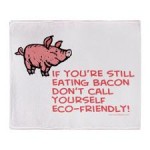Cloudy with a Chance of Lettuce
 With the anticipation of having to drastically cut back on my meat consumption in the coming weeks, I started to focus much more on the types of food that I most commonly choose. Almost without fail my lunch and dinner consisted of some type of meat. Whether it was a sandwich, chicken or any of the other sometimes sketchy looking meats served in the dining hall, there was always meat on my plate. After noticing this behavior trend, I began wondering what it was about meat that drew not only me in but, from what I observed, most of the other college students around me as well. Could it have something to do with the taste or maybe the protein? Or was meat so popular because it always has been a major food source dating back to the time of our ancestors?
With the anticipation of having to drastically cut back on my meat consumption in the coming weeks, I started to focus much more on the types of food that I most commonly choose. Almost without fail my lunch and dinner consisted of some type of meat. Whether it was a sandwich, chicken or any of the other sometimes sketchy looking meats served in the dining hall, there was always meat on my plate. After noticing this behavior trend, I began wondering what it was about meat that drew not only me in but, from what I observed, most of the other college students around me as well. Could it have something to do with the taste or maybe the protein? Or was meat so popular because it always has been a major food source dating back to the time of our ancestors?
Before trying to answer these questions on a broader scale, I thought about what was so appealing to me about meat. Sure I was fed it consistently as a child and told that it was important to keep my iron levels high. However, as I got older (and hopefully wiser) I discovered negative sides to eating meat as well. Some of these harmful effects include the calorie content that even small amounts of meat hold, the killing and abuse of animals, and the harmful repercussions that escalate into the environment. The irony of this almost made me chuckle because my health, animals and the environment are three things that I have always stressed great importance on in my life. In addition to these findings being a little amusing, they also gave me even more determination to not only cut back on my meat consumption for this project but also for those things that I put great value to in society.
Three hundred and ninety-eight young Dutch females participated in a sustainable food consumption challenge similar to the one that I am doing. Instead of just reducing the meat intake, these women reduced their meat and dairy consumption. The findings were then documented in an article titled, Replacement of meat and dairy by plant-derived foods: estimated effects on land use, iron and SFA intakes in young Dutch adult females. (Temme, van der Voet, Thissen, Verkailk-Kloosterman, van Donkersgoed, Nonhebel 2013) From the findings, the conclusion was made that by decreasing meat and dairy consumption the environment benefitted because less land was needed. In addition, the women were not negatively effected because the plant-based food they were given ensured that their iron levels were not compromised.
When thinking about cutting back on sandwiches and chicken this project seems incredibly difficult. However, when I think about my health and on a larger scale the animals and the environment that will be helped just a little bit this project takes on a whole new meaning.
Temme, E., der Voet, H. v., Thissen, J. T., Verkaik-Kloosterman, J., Donkersgoed, G. v., & Nonhebel, S. (2013). Replacement of meat and dairy by plant-derived foods: estimated effects on land use, iron and SFA intakes in young Dutch adult females. Web of Science, 16(10), 1900-1907. Retrieved October 27, 2013, from http://0- full_record.doapps.webofknowledge.com.libcat.lafayette.edu/?product=WOS&search_mode=Refine&qid=2&
Leave a Reply